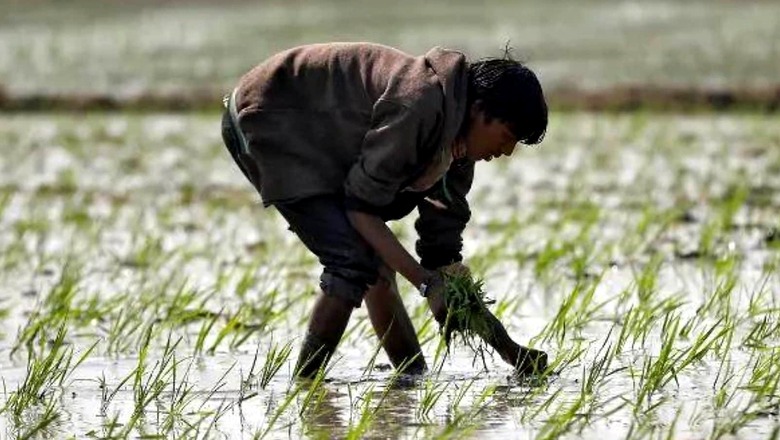
views
The agricultural industry has been making headlines for quite some time now, be it the withdrawal of three farm laws, which were engulfed by unprecedented, massive protests or how agritech startups are trying to fix some of the major issues faced by India’s agriculture sector.
By using innovative business models backed by artificial intelligence, data analytics, blockchain, remote sensing, spectroscopy and machine learning, agritech firms are also trying to alter the landscape of agriculture.
They are trying to address fundamental issues such as poor soil and seed quality, climate change, substandard storage facilities, complex supply chain, unavailability of information, inaccessible credit facilities and inferior quality control.
Combination of agritech and traditional farming knowledge can facilitate farmers in producing high quality yield and generate high revenues as well.
How Agritech Helped During Pandemic
The agricultural industry found itself in a total disarray as mobility restrictions led to shortage of farm labourers. Input supply chains froze, farmers struggled to access markets and storage facilities, cost of products pinched, fluctuating prices and limited access to financing underscored the urgent need to transform agriculture.
The worst part of Covid-induced nationwide lockdown was that it coincided with the country’s peak harvesting time. Summer fruits and vegetables were ready to pick; wheat, barley and paddy were set for harvest, but the nation came to a grinding halt.
Despite the initial setback amid the lockdown, agriculture is the only sector to have reported a growth in the first quarters for three years in a row — and this was possible due to agritech. Interestingly, agritech grew 4.5% during the June quarter, as per the National Statistical Office’s latest report.
Agritech helped the sector stabilise and churn volume-based business. Solutions offered by agritech startups were agile and were able to withstand market inefficiencies.
During Covid-19, farmers found it very difficult to source input supplies locally. Companies selling agri-inputs online jumped at the opportunity and offered contactless delivery of required tools. Farmers could go online and choose from a variety of options and price ranges. They were able to procure inputs easily and hassle-free, thanks to agritech.
Similarly, on the output side, since ‘mandis’ were not operating normally and posed serious risk of Covid contraction, eMandis and eSelling surged. Online platforms enabled farmers to sell their produce remotely. If not for online selling, the harvest would have decayed sitting on farms or farmers would have been forced to sell it at extremely low prices.
Agritech also helped with the information, education and advisory part. When farmers had doubts about growing, buying or harvesting, a number of them turned to online advisory forums and discussion groups when they were not able to meet their peers in person. Mobile applications were sending timely climate notifications, educational videos and training content to interested farmers so that they can plan the next harvest productively.
Using technology to deal with Covid challenges, made a lot of farmers comfortable with it.
Agritech is About Complementing Farmer’s Knowledge
Agritech empowers farmers by giving them remote access to advice, inputs, and buyers across different markets keeping the influx of money intact. It helps them automate and streamline supply chains and build platforms for instant cash settlements.
A lot of pain points of traditional methods can be addressed using Agritech. Farmers can keep an eye on their yields easily and remotely using the drone technology. Produce can be protected from animal attacks with the help of electric fencing, and advanced AI models can assist with crop diagnosis and soil health sampling.
Moreover, imaging technology and remote sensing can be used to detect diseases, infections and discoloration. Digital applications can provide real-time suggestions. Better visibility of demand dynamics using data can also help avoid excess or deficit production.
Post-harvest food losses amount to nearly 40% of produce even before it reaches the end consumer. Majority of this waste can be amounted to poor quality control and inefficient supply chain. This can be addressed using digitisation.
The traditional method of testing fruits and vegetables is to send them to laboratories. Food is wasted in this process as testing is carried out by cutting fruits and vegetables. Perishable products also rot because of the time it takes for consignments to reach the lab facilities.
This process is not only slow, destructive and heavily reliant on human resources but farmers have no visibility about the interior workings of lab testing. Due to the lack of clarity around quality, farmers have to sometimes accept the unpaid prices established by the middleman.
Agritech has come up with quick, non-destructive, and precise testing methodologies. The market has handheld devices, which enable measuring food safety in terms of nutritional value, moisture and sugar content, acidity, and soluble solids.
Traditionally, farmers used to gauge the life of perishable content by its looks and feel. For instance, the looks of kiwi, sapota can be deceiving as they maintain consistent texture during their lifecycle. Moreover, at times retailers and buyers do not agree with the farmers’ assessment of product’s shelf life, which leads to disconnect and disagreement on rates. Technology can take care of all this; factors such as ripeness, uniformity, firmness, and freshness and shelf life can be accurately measured using digital devices. Quality reports from these devices give farmers bargaining power to negotiate in the open market which otherwise is difficult for them to have.
Accurate prediction of shelf life makes it easy to categorise food that can be transported to farther locations and the lot that needs to be sent to nearby local markets. These gadgets are easy to use and are connected to software that offer suggestions and traceability and maybe utilised to overcome most of the destructive testing drawbacks.
Conclusion
The events that unfolded in the past two years have exposed quite a few loopholes in our agricultural system and left us with a lot to work on. While we recover from the economic shock induced by the pandemic and fight potential food inflation, the combination of technology and our farmer community’s knowledge base can help improve overall production and quality of food.
Agriculture and its foundation goes a long way back in our history and there is no way we will be able to flourish the industry if we do not place farmers at the heart of it. Indian farming practices have been passed on to us from generations — years of learning, hard work and experiences were combined to bring us where we are today. We have technology at our disposal like never before and the trick is not just the use of it but the use of it in the right amount at the right places in the right way.
The writer is CEO & CoFounder, InfyU LABS. He is an entrepreneur, analyst and strategist from IIT Madras. The views expressed in this article are those of the author and do not represent the stand of this publication.
Read all the Latest Opinions here




















Comments
0 comment